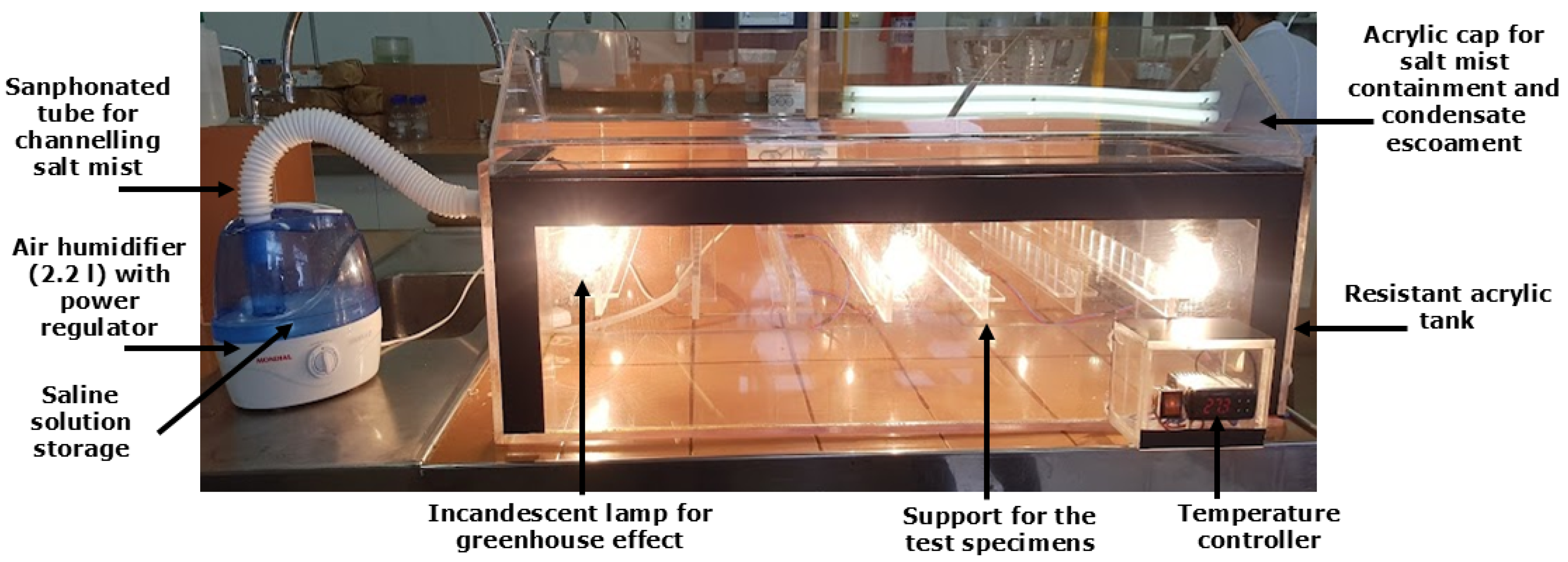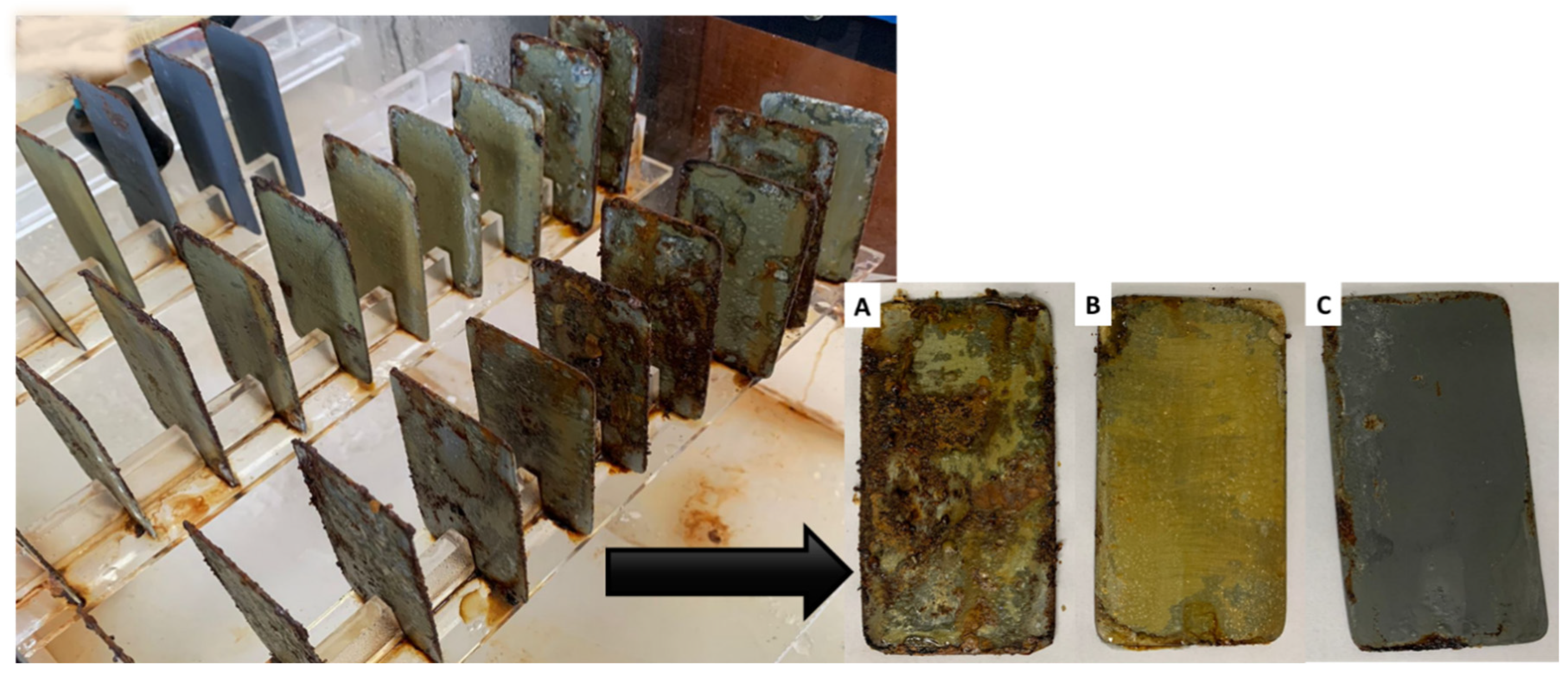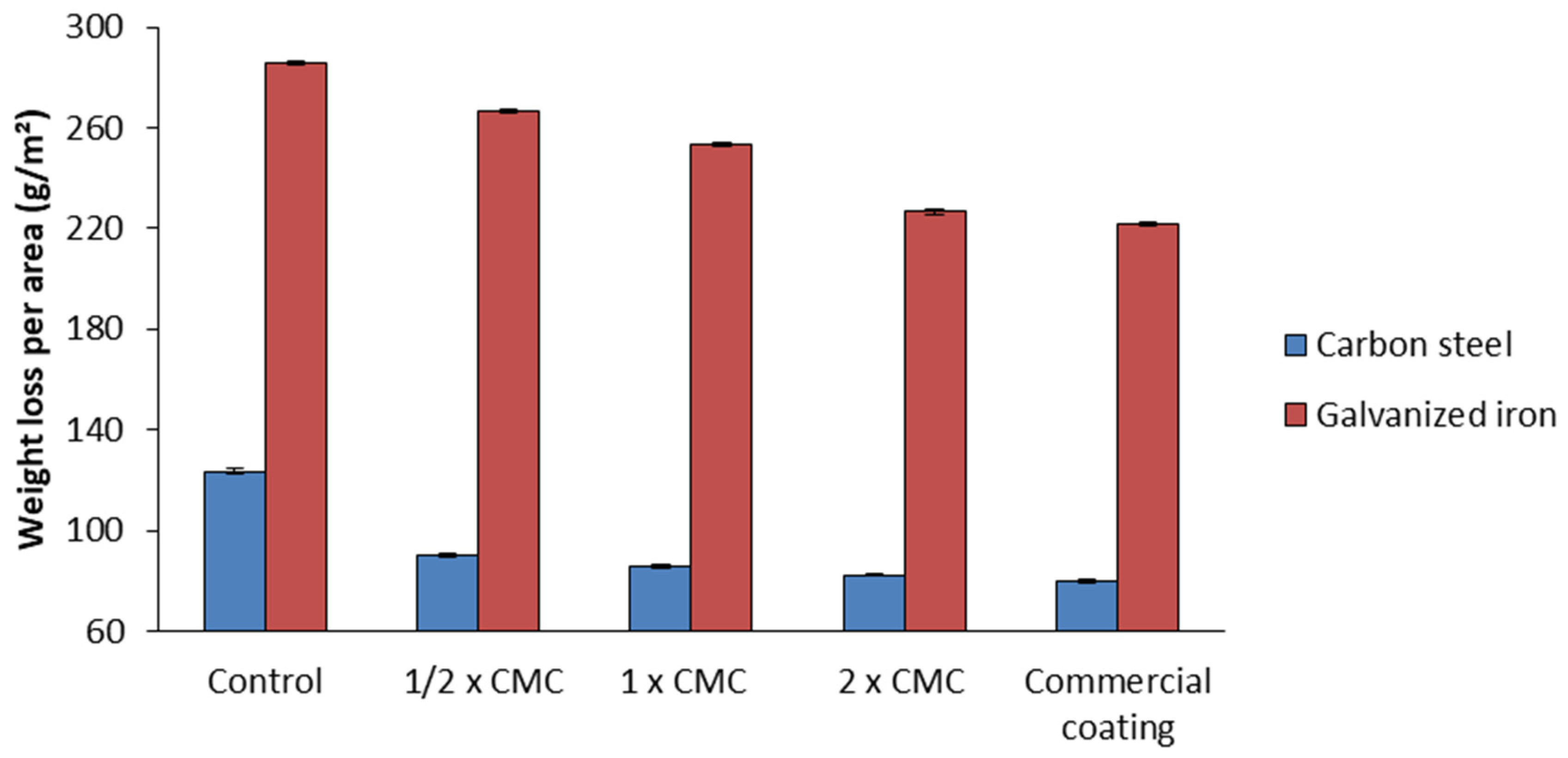Application of Pseudomonas cepacia CCT 6659 Biosurfactant as a Metal Corrosion Inhibitor in a Constructed Accelerated Corrosion Chamber (ACC)
Abstract
1. Introduction
2. Materials and Methods
2.1. Microorganism
2.2. Coating Matrices
2.3. Production of the Biosurfactant
2.4. Extraction of the Biosurfactant
2.5. Construction of the Accelerated Corrosion Chamber (ACC)
- Assembly of the salt spray chamber: the ACC, constructed using a 1.0 cm-thick acrylic tank, had dimensions of 100.0 cm in length, 40.0 cm in width and 30.0 cm in height. The chamber roof was composed of two triangular and two rectangular 3 mm-thick acrylic sheets with an opening angle of 120° so that the condensate would run down the material, avoiding dripping onto the samples during the test.
- Sample holder: to suspend the TSs, cut-out acrylic plates measuring 40.0 cm in length and 5.0 cm in width were used, in which slots were made to place the test plates (Figure 3).
- Heating system: the electric heating system consisted of incandescent lamps in ceramic sockets and a smaller acrylic box attached to the outside of the chamber, serving as a support for a temperature microprocessor digital electronic controller (model Z31A, COEL, constructed for application with on/off temperature control for heating or refrigeration, fabricated in São Paulo, Brazil).
- Spraying system: for the humidification system, a 3/4″ (19.05 mm) accordion tube coupled with an ultrasonic air humidifier, model NUA-02 (Comfort Air—Mondial, Brazil), with a capacity of 2.2 L and autonomy of 10 h was used. The humidifier was fed with a 5.0% sodium chloride (NaCl) solution.
- Spray solution collection system: the system had a specific outlet at the bottom of the acrylic tank to prevent the accumulation of liquids, allowing the collection of effluents generated by mist condensation inside the tank. The condensate was collected using a silicone hose, which directed the effluents to a reservoir for storage.
2.6. Evaluation of Corrosion on Metal Surfaces by Atmospheric Physical Factors
2.6.1. Preparation of Samples
2.6.2. Test Parameters
2.6.3. Evaluation of the Degree of Corrosion
2.7. Biodegradable Matrices for Incorporation of Pseudomonas cepacia Biosurfactant as a Metal Corrosion Inhibitor
2.8. Incorporation of Pseudomonas cepacia Biosurfactant into the Selected Biodegradable Matrix
2.9. Evaluation of Biosurfactant as a Corrosion Inhibitor Additive in Paints (Synthetic Enamel) for Metal Surfaces
2.10. Statistical Analyses
3. Results and Discussion
3.1. Accelerated Corrosion Chamber (ACC)
3.2. Parameterization Tests in the Accelerated Corrosion Chamber
3.3. Evaluation of Biodegradable Matrices for Incorporation of Pseudomonas cepacia Biosurfactant as a Metal Corrosion Inhibitor
3.4. Incorporation of Pseudomonas cepacia Biosurfactant into the Plant Resin-Based Matrix
3.5. Evaluation of the Biosurfactant as a Corrosion Inhibitor Additive in Paints (Synthetic Enamels) for Metal Surfaces
4. Conclusions
Author Contributions
Funding
Institutional Review Board Statement
Informed Consent Statement
Data Availability Statement
Acknowledgments
Conflicts of Interest
References
- Zehra, S.; Mobin, M.; Aslam, R. Application of biosurfactants as anti-corrosive agents. In Advancements in Biosurfactants Research; Aslam, R., Mobin, M., Aslam, J., Zehra, S., Eds.; Springer: Cham, Switzerland, 2023; pp. 171–189. [Google Scholar] [CrossRef]
- Cheng, X.; He, Y.; Yan, S.; Yan, L.; Li, Z.; Xu, S.; Wei, K.; Fan, Y.; Chen, Q.; Peng, W. Exploration of the mechanism of wear and seawater erosion resistance of modified MXene-reinforced Ni-Cu alloy composite coatings. Tribol. Int. 2024, 200, 110080. [Google Scholar] [CrossRef]
- Sales, D.E.L.; Takenobu, G.M.U.; Alves, L.W.S.; Perícoli, V.E.N.A. Análise da corrosão em aço 1020 utilizando meio de proteção com anticorrosivo e mistura de cloro com água como agente corrosivo. In Anais do Curso de Engenharia Mecânica da UniEvangélica, Anápolis, Brazil, 4–6 June 2018; UniEvangélica: Anápolis, Brazil, 2018; Volume II, pp. 1–9. [Google Scholar]
- Okyere, M.S. Corrosion Protection for the Oil and Gas Industry: Pipelines, Subsea Equipment, and Structures, 1st ed.; Taylor & Francis: Boca Raton, FL, USA, 2019; pp. 1–186. ISBN 978-04-2905-645-1. [Google Scholar] [CrossRef]
- Danaee, I.; Rameshkumar, S.; Rashvandavei, M.; Vijayan, M. Electrochemical and quantum chemical studies on corrosion inhibition performance of 2,2′-(2-Hydroxyethylimino) bis[N-(alphaalpha-dimethylphenethyl)-N-methylacetamide] on mild steel corrosion in 1 M HCl solution. Mater. Res. 2020, 23, 2. [Google Scholar] [CrossRef]
- Gómez Botero, M.A.; Sepúlveda, J.A.T.; González, J.G.C.; Osorio, F.J.B.; García, P.M.; Cruz, D.; Torres, J.A.M. Evaluación de metodologías para la aplicación de sistemas de protección contra la corrosión en el interior de tanques de lastre en enbarcaciones marinas. Ing. Desarro. 2017, 35, 174–197. [Google Scholar] [CrossRef]
- PROPEQ. Projeto e Pesquisa em Engenharia Química. Corrosão: O Que é e Como Evitá-La em sua Indústria. O Que é a Oxidação e sua Ligação com Processos Corrosivos; Como a Corrosão Afeta o Meio Industrial; Métodos de Proteção à Corrosão. Available online: https://propeq.com/post/corrosao-o-que-e-e-como-evitar/ (accessed on 21 September 2023).
- Verma, C.; Ebenso, E.E.; Quraishi, M.A.; Hussain, C.M. Recent developments in sustainable corrosion inhibitors: Design, performance and industrial scale applications. Adv. Mater. 2021, 2, 3806–3850. [Google Scholar] [CrossRef]
- Płaza, G.; Achal, V. Biosurfactants: Eco-friendly eco-friendly and innovative biocides against biocorrosion. Int. J. Biol. Macromol. 2020, 21, 2152. [Google Scholar] [CrossRef]
- Lavanya, M.; Machado, A.A. Surfactants as biodegradable sustainable inhibitors for corrosion control in diverse media and conditions: A comprehensive review. Sci. Total Environ. 2024, 908, 168407. [Google Scholar] [CrossRef]
- Nikolova, C.; Gutierrez, T. Biosurfactants and their applications in the oil and gas industry: Current state of knowledge and future perspectives. Front. Bioeng. Biotechnol. 2021, 9, 626639. [Google Scholar] [CrossRef]
- Rocha e Silva, N.M.P.; Meira, H.M.; Almeida, F.C.G.; Soares da Silva, R.C.F.; Almeida, D.G.; Luna, J.M.; Rufino, R.D.; Santos, V.A.; Sarubbo, L.A. Natural surfactants and their applications for heavy oil removal in industry natural surfactants and their applications for heavy oil removal in industry. Sep. Purif. Rev. 2019, 48, 267–281. [Google Scholar] [CrossRef]
- Shaikhah, D.; Loise, V.; Angelico, R.; Porto, M.; Calandra, P.; Abe, A.A.; Testa, F.; Bartucca, C.; Rossi, C.O.; Caputo, P. New trends in biosurfactants: From renewable origin to green enhanced oil recovery applications. Molecules 2024, 29, 301. [Google Scholar] [CrossRef]
- Sivakumar, D.; Ramasamy, R.; Thiagarajan, Y.R.; Thirumalairaj, B.; Krishnamoorthy, U.; Haque Siddiqui, M.I.; Lakshmaiya, N.; Kumar, A.; Shah, M.A. Biosurfactants in biocorrosion and corrosion mitigation of metals: An overview. Open Chem. 2024, 22, 20240036. [Google Scholar] [CrossRef]
- Qiu, X.; Chen, W.; Yuan, J.; Tan, X.; Liu, S.; Wu, G.; Liu, K. Equivalent relationship of accelerated corrosion based on the chloride ion diffusion property in calcium sulfoaluminate cement-based pastes. Int. Commun. Heat Mass Transf. 2024, 152, 107283. [Google Scholar] [CrossRef]
- Li, Y.; Xu, H.; He, Y.; Xu, Q.; Fan, X.; Liu, C. Study on the correlation between indoor accelerated corrosion testing of concrete epoxy polysiloxane coating and real-sea environmental testing in the East China Sea. Case Stud. Constr. Mater. 2024, 20, e02905. [Google Scholar] [CrossRef]
- Bass Equipamentos. Available online: https://www.bass.com.br/ (accessed on 14 March 2023).
- Equilam. Ensaio de Névoa Salina. Available online: https://equilam.com.br/ (accessed on 22 December 2023).
- TESTEX Instrument LTD. Available online: https://www.testextextile.com/pt/produto/testador-de-spray-de-sal-tu380/ (accessed on 23 December 2023).
- Soares da Silva, R.C.F.; Almeida, D.G.; Meira, H.M.; Silva, E.J.; Farias, C.B.B.; Rufino, R.D.; Sarubbo, L.A. Production and characterization of a new biosurfactant from Pseudomonas cepacia grown in low-cost fermentative medium and its application in the oil industry. Biocatal. Agric. Biotechnol. 2017, 12, 206–215. [Google Scholar] [CrossRef]
- Farias, C.B.B.; Soares da Silva, R.C.F.; Almeida, F.C.G.; Santos, V.A.; Sarubbo, L.A. Removal of heavy oil from contaminated surfaces with a detergent formulation containing biosurfactants produced by Pseudomonas spp. PeerJ 2021, 9, e12518. [Google Scholar] [CrossRef] [PubMed]
- Assis, S.L. Estudo Comparativo de Ensaios Acelerados Para Simulação da Corrosão Atmosférica. Master’s Thesis, IPEN, Autarquia Associada à Universidade de São Paulo, São Paulo, Brazil, 2000. [Google Scholar]
- ASTM B117-11; Standard Practice for Operating Salt Spray (Fog) Apparatus. American Society for Testing and Materials (S.I.): West Conshohocken, PA, USA, 2011; pp. 1–12.
- Souza, D.O.; Hammel, N.P.; Santos, W.I.A.; Ramirez, A.H.; Rojo, N.; Costa, I. Investigação da corrosividade do ensaio de névoa salina segundo norma ISO 9227. In Proceedings of the Encontro e Exposição Brasileira de Tratamento de superfície III INTERFINISH Latino Americano, Taboão da Serra, Brazil, 11–13 April 2012; pp. 360–367. [Google Scholar]
- Gentil, V. Corrosão, 6th ed.; LTC—Livros Técnicos e Científicos: Rio de Janeiro, Brazil, 2012; pp. 1–376. ISBN 978-852-161-804-1. [Google Scholar]
- Rodrigues, L.M. Desenvolvimento de Equipamento Para Realização de Ensaios Com Névoa Salina Para Avaliar a Resistência à Corrosão em Metais. Master’s Thesis, Centro Universitário de Volta Redonda, Volta Redonda, Brazil, 2017. [Google Scholar]
- Associação Brasileira de Normas Técnicas. Material Metálico Revestido e Não Revestido: Corrosão Por Exposição à Névoa Salina; NBR 8094; ABNT: Rio de Janeiro, Brazil, 1983. [Google Scholar]
- Dantas, E. Geração de Vapor e Água de Refrigeração, 2nd ed.; Ecolab Química Ltd.a: Rio de Janeiro, Brazil, 1988; pp. 1–305. [Google Scholar]
- Oliveira, S.H. Estudo da Utilização da Xantana e Hipoclorito de Sódio Como Estratégia Para Controle da Biocorrosão. Ph.D. Thesis, Universidade Federal de Pernambuco, Recife, Brazil, 2010. [Google Scholar]
- Acevedo, M.S.; Puentes, C.; Carreño, K.; León, J.G.; Stupak, M.; García, M.; Pérez, M.; Blustein, G. Antifouling paints based on marine natural products from Colombian Caribbean. Int. Biodeterior. Biodegrad. 2013, 83, 97–104. [Google Scholar] [CrossRef]
- Pontes, J.F.R.; Bendinelli, E.V.; Amorim, C.C.; Sá, M.M.; Ordine, A.P. Effect of corrosion inhibitor used in surface treatment on the anticorrosive performance of an epoxy paint system. Mater. Sci. Appl. 2016, 7, 593–609. [Google Scholar] [CrossRef]
- Qian, X.; Jin, K.; Lu, S.; Lv, L. Research on salt spray test of power facilities based on standardized laboratory construction. IOP Conf. Ser. Mater. Sci. Eng. 2020, 782, 032013. [Google Scholar] [CrossRef]
- ISO 9227:2017; Corrosion Tests in Artificial Atmospheres-Salt Spray Tests. International Organization for Standardization: Geneva, Switzerland, 2017. Available online: www.iso.org (accessed on 20 October 2024).
- Ostroski, V.C. Avaliação da velocidade de corrosão nos equipamentos portuários. Rev. Gestão Sustentabilidade Ambient. 2019, 8, 848–880. [Google Scholar] [CrossRef][Green Version]
- Santos, F.R.; Panossian, Z. Comparative study of the corrosion resistance of zinc electrodeposits obtained in chloride bath with additives and in sulfate/chloride bath without additives part 2: Corrosion resistance of the electrodeposits. Tecnol. Metal. Mater. Miner. 2018, 15, 137–143. [Google Scholar] [CrossRef]
- Hemapriya, V.; Prabakaran, M.; Chitra, S.; Swathika, M.; Kim, S.; Chung, I. Utilization of biowaste as an eco-friendly biodegradable corrosion inhibitor for mild steel in 1 mol/L HCl solution. Arab. J. Chem. 2020, 13, 8684–8696. [Google Scholar] [CrossRef]
- Fernandes, C.M.; Mello, M.V.P.; Santos Júnior, N.E.; Souza, A.M.T.; Lanznaster, M.; Ponzio, E.A. Theoretical and experimental studies of a new aniline derivative corrosion inhibitor for mild steel in acid medium. Mater. Corros. 2020, 71, 280–291. [Google Scholar] [CrossRef]
- Fawzy, A.; Abdallah, M.; Alfakeer, M.; Altass, H.M.; Althagafi, I.I.; El-ossaily, Y.A. Performance of unprecedented synthesized biosurfactants as green inhibitors for the corrosion of mild steel-37-2 in neutral solutions: A mechanistic approach. Green Chem. Lett. Rev. 2021, 14, 488–499. [Google Scholar] [CrossRef]
- Fawzy, A.; Al Bahir, A.; Alqarni, N.; Toghan, A.; Khider, M.; Ibrahim, I.M.; Abulreesh, H.H.; Elbanna, K. Evaluation of synthesized biosurfactants as promising corrosion inhibitors and alternative antibacterial and antidermatophytes agents. Sci. Rep. 2023, 13, 2585. [Google Scholar] [CrossRef] [PubMed]
- Faccioli, Y.E.S.; Oliveira da Silva, G.; Soares da Silva, R.C.F.; Sarubbo, L.A. Application of a biosurfactant from Pseudomonas cepacia CCT 6659 in bioremediation and metallic corrosion inhibition processes. J. Biotechnol. 2022, 351, 109–121. [Google Scholar] [CrossRef]
- Semeniuk, I.; Karpenko, O.; Banya, A.; Lubenets, V.; Shapovalenko, S.; Pengxiang, G. New environmentally friendly compositions as inhibiors of metal corrosion. Sci. Study Res. Chem. C. 2023, 24, 41–48, ISSN 1582-540X. [Google Scholar]
- Wang, Q.; Yan, Z. Potential of biosurfactants in corrosion inhibition. In Industrial Applications of Biosurfactants and Microorganisms: Green Technology Avenues from Lab to Commercialization; Aslam, R., Aslam, J., Hussain, C.M., Eds.; Academic Press: Cambridge, MA, USA, 2024; pp. 277–305. [Google Scholar] [CrossRef]












| Commercial Synthetic Enamels | |||
|---|---|---|---|
| Type A | Type B | Type C | |
| Characteristics | Easy to apply, quick-drying enamel, with good coverage | Quick-drying synthetic enamel | Premium quick-drying synthetic enamel |
| Color | Ice white | Glossy ivory, with a satin finish | Bright white (snow) |
| Composition | Alkyd resin, based on polyacids, polyalcohols, drying oils, active pigments, additives, aliphatic solvent and turpentine | Resin comprising polyacids and polyalcohols, solvents, additives and pigments | Light hydrous petroleum distillates, xylene, toluene, cobalt octoate, manganese octoate, methyl ethyl ketoxime |
| Application | Suitable for external and internal surfaces of wood, metal and masonry | Suitable for external application on wood, metal, galvanized material and aluminum | Suitable for application on wood, ferrous metals, aluminum, galvanized material and masonry surfaces |
| Component | Matrices | |||
|---|---|---|---|---|
| A | B | C | D | |
| Rosin resin (%) | 27 | 27 | 27 | 27 |
| Oleic acid (%) | 6 | 6 | - | 6 |
| Xylene (%) | 20 | - | 20 | - |
| Acetone (%) | - | 20 | 6 | - |
| Ethanol (%) | - | - | - | 20 |
| CaCO3 (%) | 11 | 11 | 11 | 11 |
Disclaimer/Publisher’s Note: The statements, opinions and data contained in all publications are solely those of the individual author(s) and contributor(s) and not of MDPI and/or the editor(s). MDPI and/or the editor(s) disclaim responsibility for any injury to people or property resulting from any ideas, methods, instructions or products referred to in the content. |
© 2024 by the authors. Licensee MDPI, Basel, Switzerland. This article is an open access article distributed under the terms and conditions of the Creative Commons Attribution (CC BY) license (https://creativecommons.org/licenses/by/4.0/).
Share and Cite
Soares da Silva, R.d.C.F.; Selva Filho, A.A.P.; Faccioli, Y.E.S.; Silva, Y.K.; Oliveira, K.W.; Araujo, G.P.; Rocha e Silva, N.M.P.; Converti, A.; Sarubbo, L.A. Application of Pseudomonas cepacia CCT 6659 Biosurfactant as a Metal Corrosion Inhibitor in a Constructed Accelerated Corrosion Chamber (ACC). Fermentation 2024, 10, 602. https://doi.org/10.3390/fermentation10120602
Soares da Silva RdCF, Selva Filho AAP, Faccioli YES, Silva YK, Oliveira KW, Araujo GP, Rocha e Silva NMP, Converti A, Sarubbo LA. Application of Pseudomonas cepacia CCT 6659 Biosurfactant as a Metal Corrosion Inhibitor in a Constructed Accelerated Corrosion Chamber (ACC). Fermentation. 2024; 10(12):602. https://doi.org/10.3390/fermentation10120602
Chicago/Turabian StyleSoares da Silva, Rita de Cássia F., Alexandre Augusto P. Selva Filho, Yslla Emanuelly S. Faccioli, Yasmim K. Silva, Kaio W. Oliveira, Gleice Paula Araujo, Nathália Maria P. Rocha e Silva, Attilio Converti, and Leonie A. Sarubbo. 2024. "Application of Pseudomonas cepacia CCT 6659 Biosurfactant as a Metal Corrosion Inhibitor in a Constructed Accelerated Corrosion Chamber (ACC)" Fermentation 10, no. 12: 602. https://doi.org/10.3390/fermentation10120602
APA StyleSoares da Silva, R. d. C. F., Selva Filho, A. A. P., Faccioli, Y. E. S., Silva, Y. K., Oliveira, K. W., Araujo, G. P., Rocha e Silva, N. M. P., Converti, A., & Sarubbo, L. A. (2024). Application of Pseudomonas cepacia CCT 6659 Biosurfactant as a Metal Corrosion Inhibitor in a Constructed Accelerated Corrosion Chamber (ACC). Fermentation, 10(12), 602. https://doi.org/10.3390/fermentation10120602








